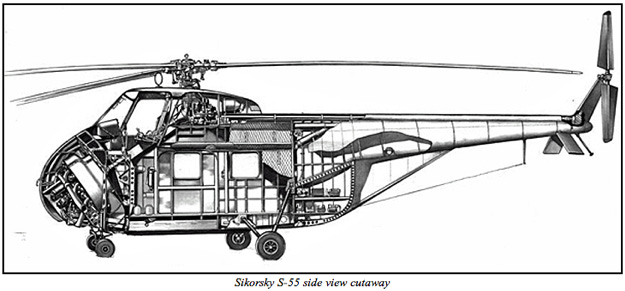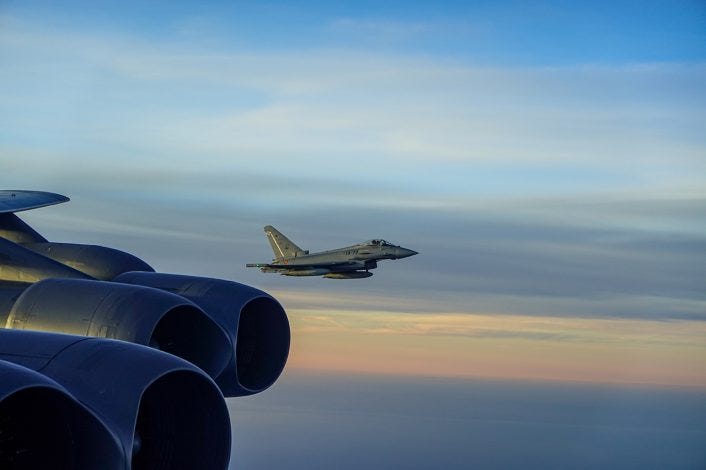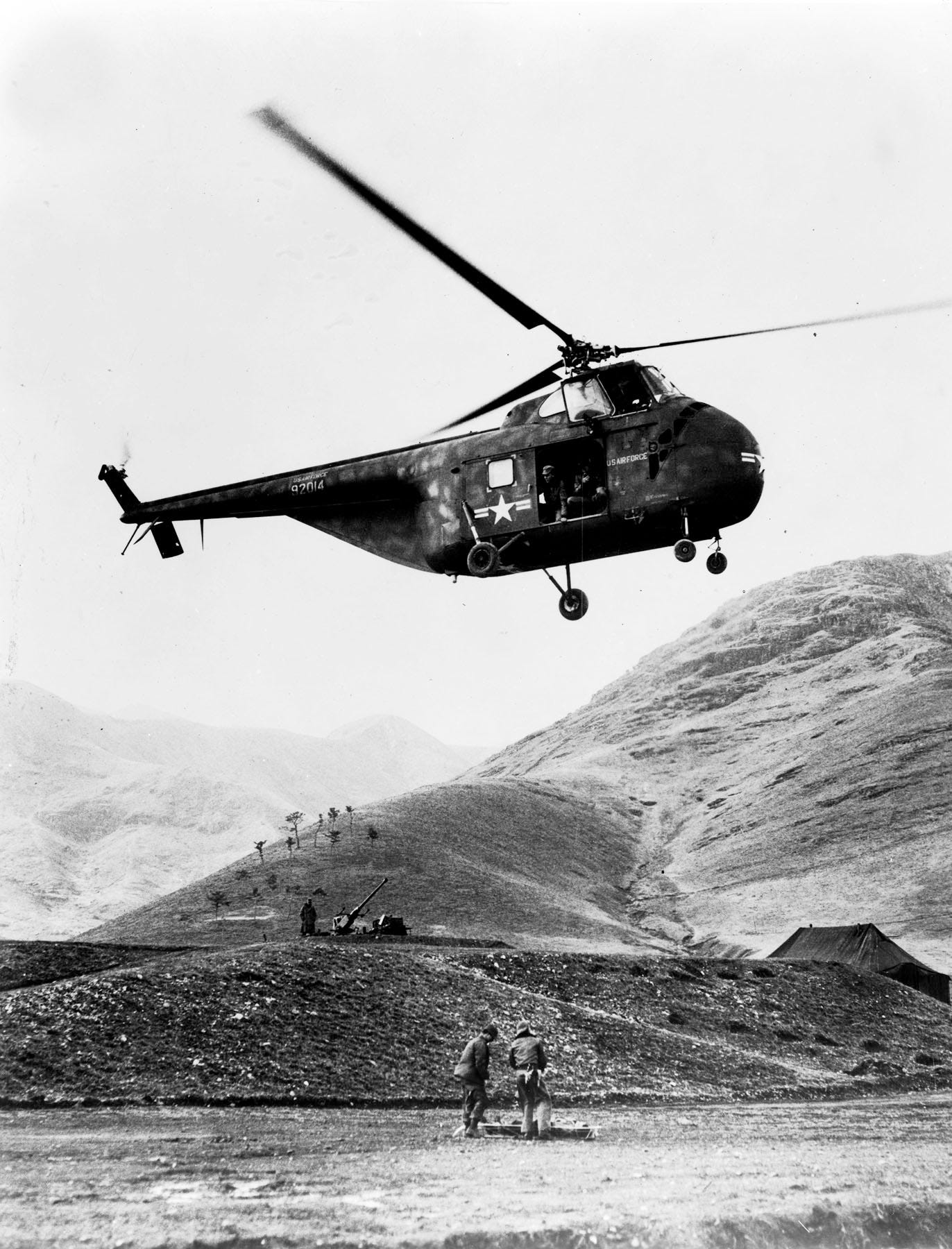BUFFs Over Europe: The B-52 Returns to the Front Line
Three B-52 Stratofortresses arrive in Spain for a new Bomber Task Force rotation as we look back at the 1949 debut of Sikorsky’s S-55—the helicopter that changed air mobility forever.
“The B-52 is the only aircraft that will be flown by the grandparents, parents, and children of the same family—it’s that enduring.”
— General Robin Rand, former Commander, Air Force Global Strike Command
Before we taxi into this week’s stories, it’s important to pause for a moment of reflection. Today is Veterans Day, a time to honor all those who have worn the uniform of the United States Armed Forces. From the bomber crews who braved icy skies over Europe, to the helicopter pilots who risked everything to rescue the wounded under fire, to those who continue to serve in today’s ever-changing world—each has carried forward the legacy of courage, sacrifice, and dedication that keeps our nation free. To all veterans—past, present, and future—thank you for your service, your strength, and your steadfast commitment to the mission.
Mission Briefing
As the sun dipped below the horizon on November 8, the unmistakable silhouette of three B-52H Stratofortresses appeared over southern Spain. Their eight engines trailed the familiar black smoke that has long been the calling card of America’s most enduring bomber. The trio, call signs CAGER 11, 12, and 13, had crossed the Atlantic from Barksdale Air Force Base, Louisiana, marking the start of the first European Bomber Task Force (BTF) deployment of the new fiscal year. Their destination: Morón Air Base, a long-standing hub for U.S. strategic aviation in Europe.
This latest deployment—BTF Europe 26-1—is part of the Air Force’s ongoing rotation of long-range bombers across the globe, designed to sharpen readiness, enhance allied integration, and reinforce deterrence. Supported by KC-135 Stratotankers and KC-46 Pegasus refuelers, the aircraft from the 2nd Bomb Wing will operate across Europe, Africa, and the Middle East, executing complex mission profiles that test every element of their crews’ skill sets.
According to the U.S. Air Force, these missions will simulate operations in “complex, high-threat airspace,” challenging aircrews to master the find, fix, track, and target process while responding to simulated ground and air-based threats. In essence, these are rehearsals for the most demanding strike scenarios imaginable—precisely the kind of environment the B-52 has been evolving to survive in for over seven decades.
A Veteran Still Evolving
First introduced in the 1950s, the B-52 Stratofortress—or BUFF (“Big Ugly Fat Fellow”) as its crews affectionately call it—has been modernized continuously to keep it combat-relevant. The current B-52H model, powered by eight Pratt & Whitney TF33 turbofans, will soon receive a significant upgrade under the Commercial Engine Replacement Program (CERP), which will see the aging engines replaced with modern Rolls-Royce F130s. These new engines promise to extend the BUFF’s service life well beyond its 100th birthday, reduce fuel burn, and increase reliability.
In addition, the aircraft’s analog cockpit is being replaced with a fully digital “glass” avionics suite, and its radar—originally designed in the 1960s—is being swapped for a cutting-edge active electronically scanned array (AESA) system derived from the F/A-18 Super Hornet. This modernization effort ensures that the B-52H remains a credible platform for standoff weapons like the AGM-86 ALCM and the forthcoming Long Range Stand Off (LRSO) missile.
NATO Integration and Mock Intercepts
As part of the BTF rotation, U.S. crews will integrate with new NATO allies—Finland and Sweden—who continue to build experience in combined air operations. During previous deployments, B-52s marked key milestones such as Sweden’s first anniversary as a NATO member, flying joint exercises with Swedish Gripens.
Upon their arrival over Europe this month, the BUFFs were “welcomed” in classic NATO style: with mock intercepts by allied fighters. Portuguese and Spanish Air Force jets practiced intercept profiles against the incoming bombers, coordinating with the U.S. crews via HF radio. Spanish Eurofighter Typhoons—known locally as C.16 Tifón—joined the formation for a photo op that perfectly encapsulated NATO’s unity in the skies.
A Global Message
While these missions provide invaluable training, their symbolic weight is equally important. The sight of B-52s operating freely over Europe sends a clear message: America’s strategic reach is as strong as ever, and its commitment to NATO remains unshakable. The forward deployment of these aircraft allows for rapid escalation if needed, particularly as the U.S. shifts away from maintaining permanent bomber presences in the Middle East and Indo-Pacific.
Each B-52’s arrival in Europe is both a routine deployment and a reminder—this Cold War icon still casts a long shadow. And with its upcoming upgrades, the Stratofortress is on track to remain on the flight line into the 2050s, making it one of the longest-serving combat aircraft in history.
This Week in Aviation History
“The Birth of the Workhorse: The Sikorsky S-55 Takes Flight”
On November 10, 1949, a crisp autumn morning in Bloomfield, Connecticut, test pilot Dimitry “Jimmy” Viner—nephew of legendary helicopter pioneer Igor Sikorsky—lifted a strange-looking new aircraft into the air for the first time. It was the Sikorsky S-55, serial number 55-001, a machine that would redefine what helicopters could do. The U.S. Air Force had already taken an interest in the design, giving it the designation YH-19, and that day’s short hop marked the beginning of one of the most influential helicopter lineages in aviation history.

Up to that point, most helicopters were compact, underpowered, and limited in payload. The S-55 changed that overnight. By moving the engine from beneath the main rotor to the nose, angled downward to drive the transmission via a long shaft, Sikorsky engineers freed up a cavernous cabin beneath the rotor system. For the first time, a helicopter could carry troops, stretchers, or cargo inside—a simple design decision that transformed the helicopter from an experimental novelty into a genuine battlefield asset.
From Prototype to War Hero
Five YH-19 test aircraft were built, and two were rushed to Korea for combat evaluation. The results spoke for themselves. The rugged airframe and large cabin made it an instant hit with front-line units desperate for rapid casualty evacuation and troop transport. Before long, the Air Force ordered 50 H-19A Chickasaws, followed by hundreds more improved variants. The Army, Navy, Marine Corps, and Coast Guard quickly followed suit—each branch ordering versions tailored for transport, rescue, or anti-submarine duties.
All told, Sikorsky built 1,281 S-55-series helicopters, with hundreds more produced under license by Westland in the UK, SNCASE in France, and Mitsubishi in Japan. The aircraft’s influence spread globally—used for everything from civilian airline routes to Arctic rescues and shipboard operations.
Engineering Ingenuity
The S-55 was as elegant as it was practical. Its three-bladed fully articulated main rotor—a marvel of post-war metallurgy—used hollow aluminum spars pressurized with nitrogen. A small indicator at each blade root would change color if pressure was lost, warning mechanics of a crack long before catastrophic failure. The helicopter’s Pratt & Whitney R-1340 Wasp engine produced 600 horsepower, enough to carry a useful load over 400 miles at a cruise speed just above 100 miles per hour.
Later versions adopted the more powerful Wright R-1300 Cyclone 7, pushing output to 800 horsepower. Inside, the S-55 could carry up to ten passengers or six stretchers, and its clamshell nose doors allowed maintenance crews to reach the engine without removing panels—a mechanic’s dream in the field.
Legacy of a Lifesaver
The S-55’s legacy goes far beyond its technical merits. It laid the foundation for the UH-34 Choctaw, HH-3 Jolly Green Giant, and even the Black Hawk that would follow in its footsteps. And behind its success was Jimmy Viner himself—a test pilot who had already made history in 1945, performing the world’s first hoist rescue at sea when he lifted two sailors from a sinking barge off the Connecticut coast in a Sikorsky R-5.
After that November day in 1949, Viner continued to shape rotary-wing flight, logging over 1,000 helicopter hours and helping his uncle’s company transform vertical lift from a dream into doctrine.
Today, the original YH-19 prototype, tail number 49-2012, proudly hangs in the Smithsonian’s National Air and Space Museum—a reminder of how one bold design, and one daring test flight, ushered in the age of the utility helicopter.
In Case You Missed It
The NASA/Lockheed X-59 has flown:
Photo Outlet
Every issue of Hangar Flying with Tog gets you a free image that I’ve taken at airshows:
Feel free to use these photos however you like, if you choose to tag me, I am @pilotphotog on all social platforms. Thanks!
Post Flight Debrief
Like what you’re reading? Stay in the loop by signing up below—it’s quick, easy, and always free.
This newsletter will always be free for everyone, but if you want to go further, support the mission, and unlock bonus content, consider becoming a paid subscriber.
Your support keeps this flight crew flying—and I couldn’t do it without you.
– Tog






